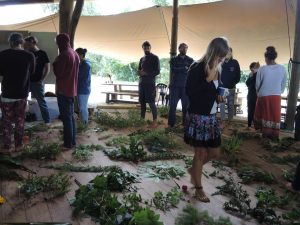Each day was begun by learning some relevant Maori language. I have grown a deep appreciation for the way their words show how valuable connection to the earth and each other is. Many words encompass feelings and ideas, and have deeper meanings to them than can possibly be expressed in english. The words were shared by a super sweet girl of Maori descent, Ngaire (one of my new favorite humans ever), and one of her goals of taking the permaculture course is to help re-organize her local Marae to be more effecitve and connected.
Here are some of my favorite words.
“Kaitiakitanga” – An obligation to implement care and protection of all forms of life, and to look after and respect the earth mother and sun father
“Kaitiaki” – A caretaker of the land, who nurtures it and ensures it will always provide abundant life
“Uri” – Offspring of the earth parents (all of life is the children of the of the sun, mountains, waters, and forests)
“Hau” (wind), “Maunga” (mountain), “Awa” (river), and “Rakau” (tree). All of these elements of the natural world are considered elders in the evolutionary family, and who have given birth to humans. They hold these elders in the highest respect.
“Wairua” – The spirit of the water
“Whenua” – The land, the placenta
“Koha” – The sharing of wealth to empower others. A koha is a gift given without the expect of anything in return.
“Manaakitanga” – Co-operation and equity through networking and sharing of all resources
“Whanaungatanga” – Working together
“Kotahitnga” – the unity and interconnectedness of all things
“Uakaipoo” – A personal place that specifically makes an individual feel aligned with the spirit of mother nature
“Turangawaewae” – A place to stand, a home and a community
“Noa” – To bring back to earth, make normal again, grounding
“Tapu” – Sacred and spiritually connected
“Tikanga” – Indigenous wisdom as everyday practice






